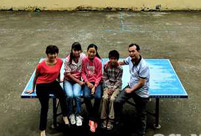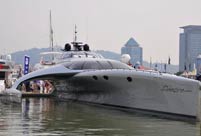Beijing Municipal Government will soon issue an emergency response to the lingering smog, with alternate driving days for even- and odd-numbered license plates, Xinhua has learned.
When the alert for air pollution goes red, the system will be initiated automatically, according to the Beijing Municipal Heavy Air Pollution Emergency Response Program. Kindergartens, primary and high schools will be suspended and 30 percent of government cars will be halted.
If the system is imposed, 2 million more people are expected to rely on the public transport system. Extra buses will be laid on and the subway will operate for an extra half an hour in the evening, said Fang Li, deputy chief of the city's environmental protection bureau.
The city will adopt a four-tier color alert system for air pollution. Red alert, the highest level, indicates serious air pollution for three consecutive days.
To prevent the most serious cases, industrial plants will be closed or told to reduce production; building work, fireworks, and outdoor barbecues will be prohibited if an orange alert is issued. Orange means heavy or serious air pollution on two of the previous three days.
According to the Ministry of Environmental Protection (MEP), air with a quality index (AQI) of over 300 is defined as "serious pollution" and an AQI between 201 and 300 as "heavy pollution."
Vehicles are considered a major contributor to Beijing's smoggy skies in recent years by a research team from the Chinese Academy of Sciences, revealed that vehicle exhaust fumes contribute 22.2 percent of PM 2.5 particles in the city, exceeding the figure for industrial emissions.
PM 2.5 are airborne particles measuring less than 2.5 microns in diameter, which can pose health risks.
Figures show the city had 5.37 million vehicles by the end of August. The Beijing government has already introduced curbs to reduce car emissions and ease traffic flow, such as taking one fifth of private vehicles off roads during weekdays based on license plate numbers and imposing a quota on licenses through a lottery scheme.
Last month, the Beijing unveiled a five-year plan for air pollution control, vowing to reduce PM 2.5 by more than 25 percent from 2012 levels to within 60 micrograms per cubic meter by 2017.
Beijing and its neighbors Tianjin and Hebei saw lingering smog over the past two months although coal-consuming winter season has not come yet.
On September 18, the MEP and the governments of six provincial-level regions, including Beijing, Tianjin, provinces of Hebei, Shanxi and Shandong and Inner Mongolia Autonomous Region, signed an agreement on the prevention and control of air pollution in Beijing and its surrounding areas.
The Ministry of Finance announced Monday that the central government has budgeted 5 billion yuan (814 million U.S. dollars) for rewarding air pollution treatment efforts in such regions.
 No news of survivors in Lao Airlines crash
No news of survivors in Lao Airlines crash China's destroyer Qingdao sails out of Sydney Harbor
China's destroyer Qingdao sails out of Sydney Harbor Chinese tycoon aims to restore London's Crystal Palace
Chinese tycoon aims to restore London's Crystal Palace Admirers to bid joyful goodbye to Rubber Duck
Admirers to bid joyful goodbye to Rubber Duck Photo story: For the last three students
Photo story: For the last three students  Photo story: A day in the life of a car model
Photo story: A day in the life of a car model Chinese screen goddesses from Beijing Film Academy
Chinese screen goddesses from Beijing Film Academy  Weekly Sports Photos
Weekly Sports Photos World's most amazing yacht on display in Guangzhou
World's most amazing yacht on display in Guangzhou Photo collection of Chinese Navy
Photo collection of Chinese Navy Cold air sweeps through N China
Cold air sweeps through N China The last family in shantytowns
The last family in shantytowns UNESCO world heritage site: Montale Tower
UNESCO world heritage site: Montale Tower U.S. Senate leader announces bipartisan deal
U.S. Senate leader announces bipartisan deal Fiber-optic wedding dress show shinning in Suzhou
Fiber-optic wedding dress show shinning in Suzhou Day|Week|Month